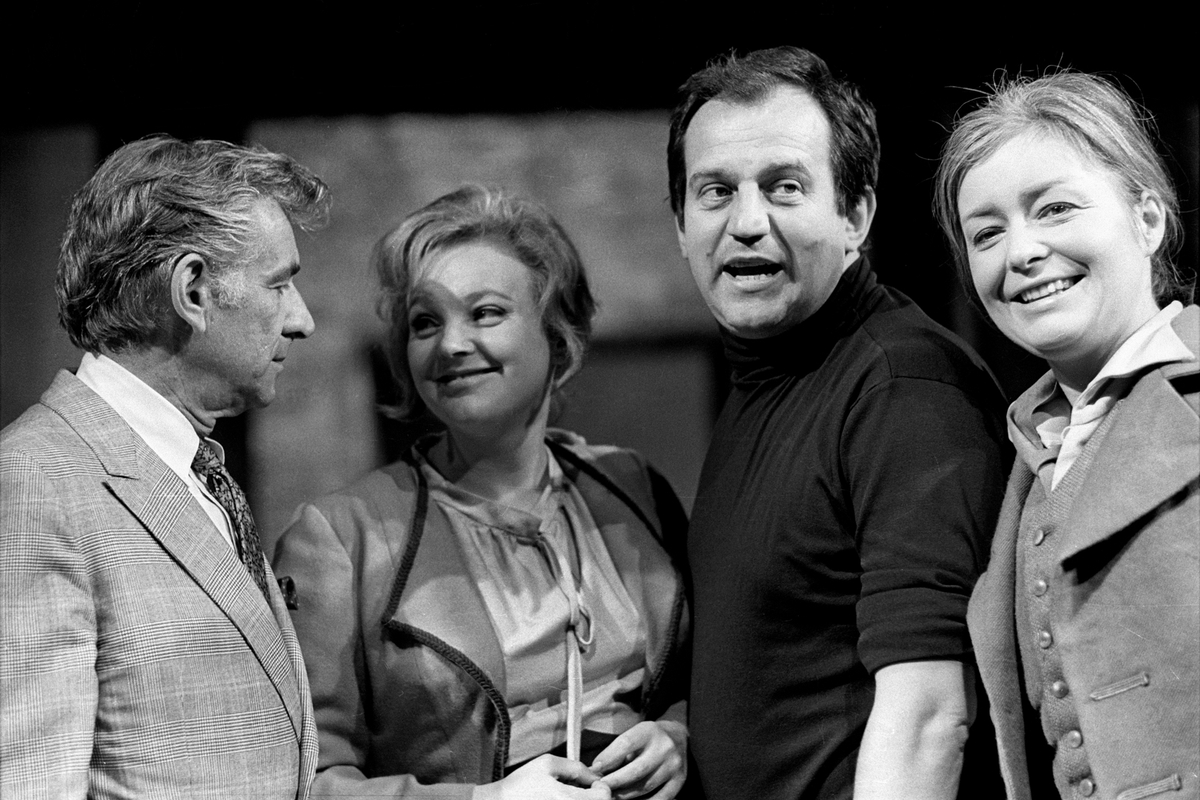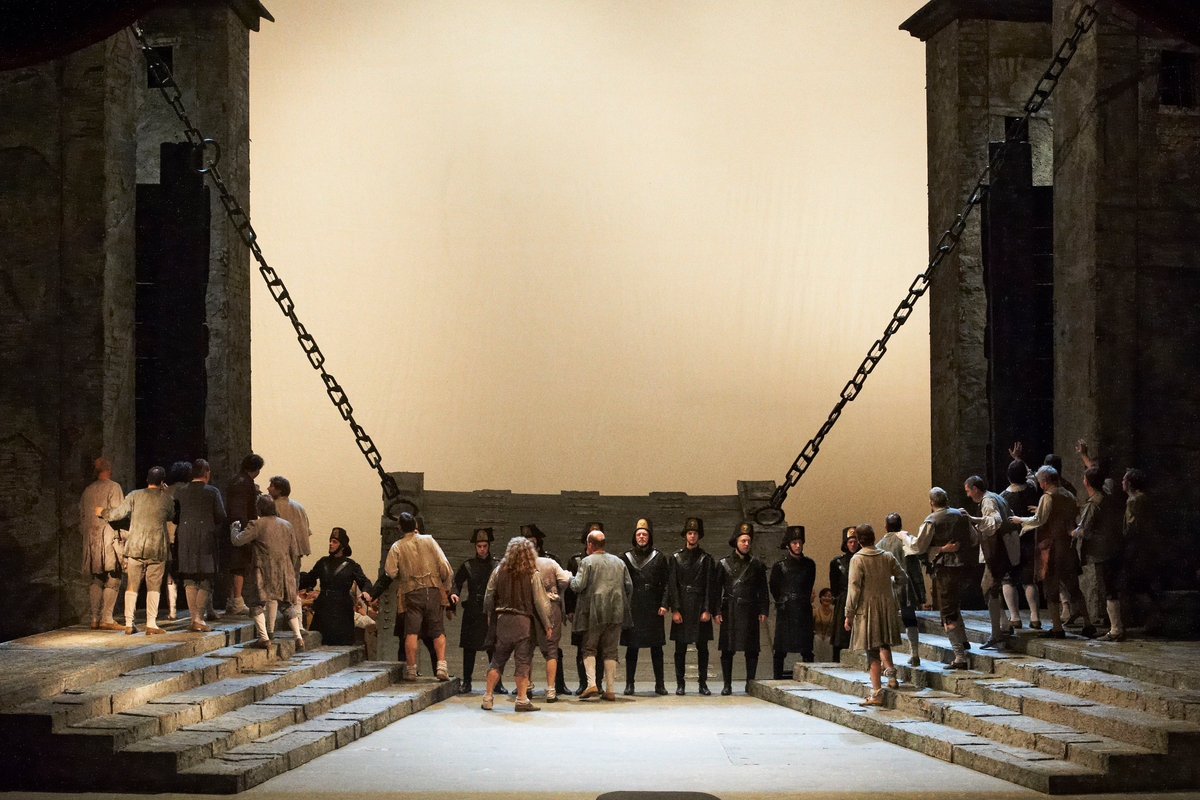»Bernstein was crying«
Interview |
One of the best staging solutions for the beginning of the final scene of Beethoven's Fidelio in your production is that of the opening drawbridge: can you remember how this idea came about?
Otto Schenk: The drawbridge is mentioned once in the opera. And it was in this context that we, Günther Schneider-Siemssen and I, came up with the idea of using this drawbridge as a symbol of freedom. We wouldn't have liked an opening gate as much as the opening drawbridge. A drawbridge already has something closed about it, something imprisoning. And when it finally opens and reveals a sea of light, so to speak - with people embracing each other - that's quite something.
I demanded of my choir that the waiting people from one side and the liberated people from the other run towards each other and hold on tightly after the drawbridge has finally lowered completely. Only then does the "All hail the day, all hail the hour" come almost as a result of the liberation. Incidentally, these embraces made me think of the people returning home in 1945, when the war was over, when liberation from tyranny had arrived. This wild, impetuous embrace of the reunited people shook me enormously at the time.
Why has Fidelio been elevated to this mythical freedom opera and not Le nozze di Figaro, which is also somehow about freedom?
Fidelio has a controversial libretto with many rough edges. For example, we don't know what kind of prisoners are being freed. Innocents? Political prisoners? Fidelio, intentionally or unintentionally, is also about being a follower. Rocco is a typical follower, a good guy, but one who has no way of defending himself. On the other side is Leonore, the woman who sets him free. A sensational idea, which Beethoven used in the first act with her magnificent aria, among other things. We also experience the difficulties in prison in Fidelio . Despite all the controversy, everything in Fidelio is imbued with what Beethoven was so enthusiastic about. The passages that have such great power in the libretto led him to create eruptive music, tender music, music of love. The touching moments are so essential that they inspired Beethoven to write his only opera. And Beethoven's rapture is transferred to the audience.
Mozart's Figaro shows something completely different, a humorous revolution that goes round the bend, in which intrigue is at work. In Fidelio , on the other hand, it's really about the matter in hand, the Eing'gemacht, as we say, and as a performer you soon lose the fear that something in the plot could be illogical. I certainly lost it during the staging. Fidelio begins with an almost Lortzing-like idyll from which a strange quartet suddenly blossoms. A quartet from which a melancholy, a world-weariness suddenly blows over. Rocco's very nice, almost silly aria could be by Lortzing again. But then: this desk perpetrator appears, the desperately malicious Pizarro, who seems so sinister from the outset. Basically, I didn't want him to be demonic at all, but so terribly matter-of-factly evil. At my premiere, Theo Adam did a wonderful job: he was almost like an intellectual knife, a real culprit.
A little later, you hear this infinitely touching prisoners' chorus, where you don't know what hurts and what doesn't hurt. We are also deeply moved by the fate of the inherently weak woman Leonore, who takes up this strange post. In her aria, a passion suddenly erupts of which Marcel Prawy once said: "That was the moment from which one could no longer dine to music, no longer drink coffee, a milestone, so to speak." In the final image, the long jubilation follows, which is mistakenly interpreted as an oratorio. For me, it was always an insane, never-ending jubilation that something had finally been broken and that a woman had brought salvation. And the Leonore-Florestan couple is representative of all of them. It is a jubilation of a length, intensity and difficulty that hardly exists in opera literature. It is not for nothing that the staged realization is often skipped. At the premiere, all the chorus members had tears of emotion in their eyes. Their faces almost melted - they weren't wearing make-up, I didn't allow that. Gwyneth Jones, James King... we were all in tears. Bernstein was crying anyway.
Does the director's perspective on Fidelio change in any way over the years, or do you always have these Sturm und Drang feelings when you approach this opera?
Well, you can't stage Fidelio without feelings of Sturm und Drang. But you can't do theater at all without Sturm und Drang. If you've gone to seed and are no longer gripped by the passion, the fanaticism, the evil in the respective great works, then you have to withdraw. At the moment, thank God, I can still make a murder pit out of my heart.
Who seduced you into Fidelio?
From the then State Opera director Egon Hilbert. Hilbert said that I had to direct Fidelio , even though I said that I couldn't do it. I never really believed in my ability. Thank God it was always others who believed in me. Once they die out, I want to die too(smiles). And then I, for my part, seduced Leonard Bernstein into this project.
He was originally supposed to do the original version of Fidelio , which I don't believe in, by the way. This original version, it's a kind of desk love of the dramaturges, which has a few beautiful passages. But Beethoven didn't decide on something else for nothing - which should be respected. After all, he understood something about music. And also about dramaturgy, as you can see.
When staging a production, do you invent a biography for each of the characters that you give the singers?
No, I don't like talking about the inner life of stage designs. I love the details that reveal the inner life, and I practise these details with the performers until they can feel the inner life. When you explain a role, you make a face that doesn't fit the role. When a singer explains his role, he makes a pseudo-intellectual face, and in such cases I always say: "What you are saying now may be true. But the way you look is not the role."

